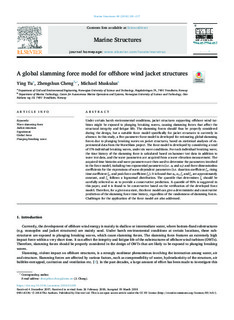| dc.contributor.author | Tu, Ying | |
| dc.contributor.author | Cheng, Zhengshun | |
| dc.contributor.author | Muskulus, Michael | |
| dc.date.accessioned | 2018-04-17T09:23:47Z | |
| dc.date.available | 2018-04-17T09:23:47Z | |
| dc.date.created | 2018-04-16T11:38:54Z | |
| dc.date.issued | 2018 | |
| dc.identifier.citation | Marine Structures. 2018, 60 201-217. | nb_NO |
| dc.identifier.issn | 0951-8339 | |
| dc.identifier.uri | http://hdl.handle.net/11250/2494412 | |
| dc.description.abstract | Under certain harsh environmental conditions, jacket structures supporting offshore wind turbines might be exposed to plunging breaking waves, causing slamming forces that affect the structural integrity and fatigue life. The slamming forces should thus be properly considered during the design, but a suitable force model specifically for jacket structures is currently in absence. In this study, a five-parameter force model is developed for estimating global slamming forces due to plunging breaking waves on jacket structures, based on statistical analyses of experimental data from the WaveSlam project. The force model is developed by considering a total of 176 individual breaking waves, under six wave conditions. For each individual breaking wave, the time history of the slamming force is calculated based on hammer test data in addition to wave test data, and the wave parameters are acquired from a wave elevation measurement. The acquired time histories and wave parameters are then used to determine the parameters involved in the force model, including two exponential parameters (i.e. α1 and α2) and three dimensionless coefficients for the expressions of wave-dependent parameters (i.e. duration coefficient ζ1, rising time coefficient ζ2, and peak force coefficient ζ3). It is found that α1, α2, ζ1 and ζ2 are approximately constant, and ζ3 follows a lognormal distribution. The quantile that determines ζ3 should be carefully selected so as to provide a conservative prediction. A quantile of 95% is suggested in this paper, and it is found to be conservative based on the verification of the developed force model. Therefore, for a given sea state, this force model can give a deterministic and conservative prediction of the slamming force time history, regardless of the randomness of slamming forces. Challenges for the application of the force model are also addressed. | nb_NO |
| dc.language.iso | eng | nb_NO |
| dc.publisher | Elsevier | nb_NO |
| dc.rights | Navngivelse 4.0 Internasjonal | * |
| dc.rights.uri | http://creativecommons.org/licenses/by/4.0/deed.no | * |
| dc.title | A global slamming force model for offshore wind jacket structures | nb_NO |
| dc.type | Journal article | nb_NO |
| dc.type | Peer reviewed | nb_NO |
| dc.description.version | publishedVersion | nb_NO |
| dc.source.pagenumber | 201-217 | nb_NO |
| dc.source.volume | 60 | nb_NO |
| dc.source.journal | Marine Structures | nb_NO |
| dc.identifier.doi | 10.1016/j.marstruc.2018.03.009 | |
| dc.identifier.cristin | 1579497 | |
| dc.description.localcode | © 2018 The Authors. Published by Elsevier Ltd. This is an open access article under the CC BY license (http://creativecommons.org/licenses/BY/4.0/) | nb_NO |
| cristin.unitcode | 194,64,91,0 | |
| cristin.unitcode | 194,64,20,0 | |
| cristin.unitname | Institutt for bygg- og miljøteknikk | |
| cristin.unitname | Institutt for marin teknikk | |
| cristin.ispublished | true | |
| cristin.fulltext | original | |
| cristin.qualitycode | 2 | |

